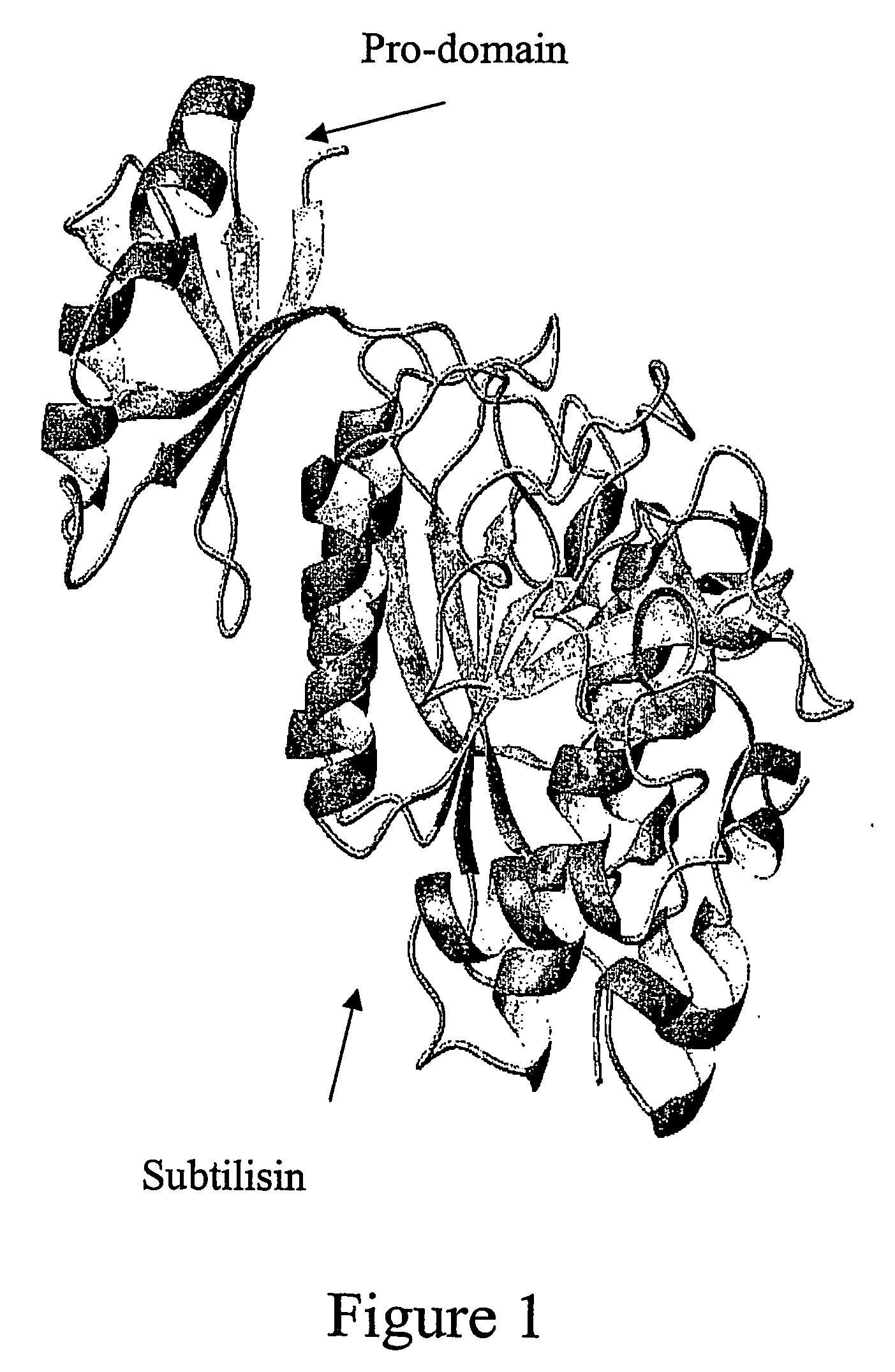Engineered proteases for affinity purification and processing of fusion proteins
a technology of affinity purification and proteases, applied in the field of purification methods, can solve the problems of difficult removal of subcellular fragments, and complex purification of recombinant proteins
- Summary
- Abstract
- Description
- Claims
- Application Information
AI Technical Summary
Benefits of technology
Problems solved by technology
Method used
Image
Examples
example 1
[0136] To demonstrate the feasibility of prodomain-directed processing, a gene was constructed to direct the synthesis of a fusion of the pR8 prodomain onto the N-terminus of the 56 amino acid B domain (GB) of streptococcal Protein G. Prodomain pR8, having the mutations at amino acid residues 16-21 (QTMST) which were replaced with SGIK creating a two amino acid deletion in pR8, wherein S replaces Q16, G replaces T17, M18I replaces S19 and T20 and “K” replaces M21; along with additional substitutions A23C, K27Q, V37L, Q40C, H72K and H75K is independently stable and binds to subtilisin with ˜100-times higher affinity than the wild type prodomain. Further, pR8 thus becomes the cognate sequence specifying the subtilisin cleavage site.
[0137] The fusion protein (1 μM) was mixed with 1 μM of wild type subtilisin. The fusion protein was rapidly and specifically cleaved to release GB from pR8. From the results several relevant observations were made including that: 1) The processing is a si...
example 2
Mutations to Decrease Subtilisin Activity Against Non-Cognate Sequences.
[0138] Using pR8 to direct cleavage in and of itself does not create a optimal processing system because of subtilisin's high activity against non-cognate sequences. The next step was to engineer subtilisin to be less active against non-cognate sequences. The starting point for engineering a processing subtilisin was a mutant denoted S149 : (Q2K, S3C, P5S, K43N, A73L, 75-83, E156S, G166S, G169A, S188P, Q206C, N212G, K217L, N218S, T254A and Q271E). S149 previously was engineered for high stability and ability to fold independently of the prodomain. These characteristics, while not essential, are highly desirable in a processing enzyme.
[0139] First, the mutations G128S and Y104A were introduced in S149 (denoted S160) to enlarge the S4 pocket [48, 51]. The catalytic properties of S149 and S160 were analyzed against two fluorogenic substrates, sDVRAF-AMC and sDFRAM-AMC, using transient state Icinetic methods. The...
example 3
[0140] A version of pR8 was constructed with its last four amino acids (AHAY) replaced with FRAM (denoted pR58). pR58 inhibits S160 with a Ki of ˜30 pM. An N-terminal fusion of pR58 onto the GB domain was found to bind to S160 with a substrate affinity (Ks) in the pM range, at least 1e5-times greater than even the highly preferred pentapeptide substrate sDFRAM-AMC. Essentially the prodomain structure acts as an amplifier of the P1 and P4 sequence signals. Hydrolysis is limited to a single turn-over by strong product inhibition. Product inhibition is difficult to avoid in using high substrate affinity to direct specific cleavage because of the structural similarity between substrate and product. We therefore do not attempt to obviate this property. As will be described later, the single turn-over reaction can be exploited in applying the system to protein purification.
[0141] A modified version of S160 with S166G was also constructed (denoted S193). The mutant prefers F and Y as P4 a...
PUM
| Property | Measurement | Unit |
|---|---|---|
| Affinity | aaaaa | aaaaa |
Abstract
Description
Claims
Application Information
 Login to View More
Login to View More - R&D
- Intellectual Property
- Life Sciences
- Materials
- Tech Scout
- Unparalleled Data Quality
- Higher Quality Content
- 60% Fewer Hallucinations
Browse by: Latest US Patents, China's latest patents, Technical Efficacy Thesaurus, Application Domain, Technology Topic, Popular Technical Reports.
© 2025 PatSnap. All rights reserved.Legal|Privacy policy|Modern Slavery Act Transparency Statement|Sitemap|About US| Contact US: help@patsnap.com



